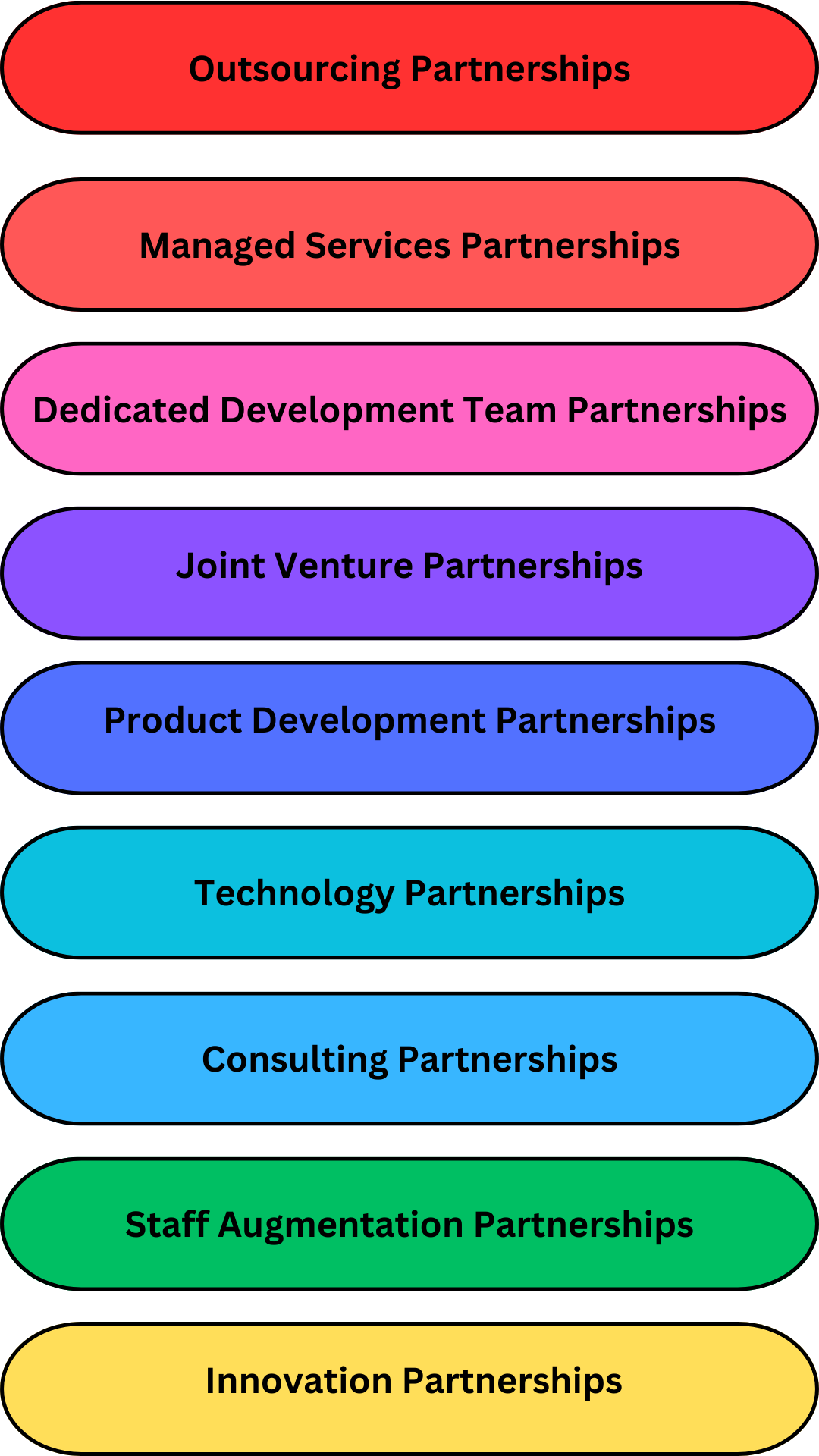A Complete Guide for Software Development Partnership
Modern businesses are inclining toward comprehensive software development partnerships to boost innovation, increase productivity, reduce costs, and acquire a leading edge in the competitive environment. A successful partnership requires extensive planning, strategy, and execution, which can be a game changer for both parties. This blog will provide a step-by-step guide to building a successful partnership.
Table of Contents
ToggleWhat is a software development partnership?
A software development partnership is a joint approach between two or more companies to design and develop software solutions. It can have several techniques, technologies, and various business models such as outsourcing, joint ventures, and, strategic alliances. There are many benefits of partnerships such as:
- Collaborating with various firms can provide unique skills and knowledge which might be not available at a point. It helps to accelerate the development process and improve the overall quality of the product.
- Businesses can share their resources and technologies which can reduce costs and increase efficiency and productivity.
- Partnering enables the sharing of risks and responsibilities that can help to mitigate the uncertain risks in the future software development process.
- The delivery time of the finished product can be greatly reduced by streamlining the development process and businesses can get the time to deploy the software faster in the market.
- Exchanging ideas among teams can increase creativity and develop innovations that would not be possible without collaboration
Types of Software Development Partnerships
There are several different types of software partnerships. Each partnership varies based on the objectives, specific goals and needs, and level of collaboration of the parties. Let us see various software development partnerships:

[1] Outsourcing Partnerships
This type of partnership involves hiring an external software development company or a team to manage specific parts or the whole development process of the software. It is a process of delegating tasks or development processes and is used when the software development agency has a lack of resources, technologies, or manpower to complete the job. Some of the most common outsourcing tasks are custom software development, mobile applications development, QA, and Testing.
Benefits of Outsourcing Partnerships
- Cost Savings
- Access to Expert Professionals
- More Flexibility and Scalability
- Faster Project Timelines
- Better Risk Management
Disadvantages
- Potential Communication Barriers
- Quality Control Issues
- Security Risks
- Increased Dependencies on External Partners
- Hidden Costs
[2] Managed Services Partnerships
This partnership involves an external party known as a Managed Service Provider or MSP, which takes the overall responsibility for the company’s technology needs and resources such as software development, AI development, cybersecurity, etc. MSP is a long-term partner of the company that handles specific functions that allow clients to focus on their business activities. MSP also provides proactive support, comprehensive coverage of a wide array of company’s needs, and cost-efficient services.
Benefits of Managed Services Partnerships
- Access to Specialized and Expert Professionals
- Reduced Costs
- Focus on Core Business
- Maintenance and Monitoring
- Scalability and Flexibility
Disadvantages
- Possible Risk of Lack of Control
- Dependency on the MSP
- Data Privacy Concerns
- Communication Challenges
- Quality Issues
[3] Dedicated Development Team Partnerships
A dedicated development team partnership comprises recruiting an external development team and experts who work solely on the company’s software or mobile app projects as an extension of the in-house development team. This type of software developer partnership enables companies to hire proficient software engineers, project managers, QA testers, etc without the need for full-time employees. The development team aligns itself with the company’s goals and objectives.
Benefits of Dedicated Development Team Partnership
- Hire Expert Professional Developers
- Cost-Effectiveness
- Highly Scalable
- Fast Rate of Development
- Enhanced Collaboration and Control
Disadvantages
- High Investment
- Long Onboarding Process
- Dependencies on the Partners
- Cultural Differences
- Timezone Differences
[4] Joint Venture
A joint venture partnership is a business collaboration between two or more companies to achieve a common goal or objective through gathering resources, hiring expertise, and technology. Joint ventures aim to develop mobile apps, offer adaptive software development, explore markets, or utilize each other’s strengths. Joint venture offers several characteristics such as sharing resources, well-defined agreements, and risk and reward sharing each other.
Benefits of Joint Venture Partnerships
- Access to New Markets
- Cost Sharing
- Faster Entry in the Market
- High Potential of Innovation
- Utilizing Strengths of Partners
Disadvantages
- Complexity in Decision Making
- Differences in Culture and Operations
- Resource and Profit Sharing Disputes
- Potential Lack of Commitment
- Risk of Intellectual Property Loss
[5] Product Development Partnerships
This type of partnership involves a collaboration of two or more parties that aim to develop, launch, or market a product together. PDP mainly focuses on co-innovation, sharing their resources and technologies, and intellectual property to launch a new product into a market. This type of partnership is generally used in large and complex projects that require specialized skills, technologies, and faster innovations.
Benefits of Product Development Partnerships
- Faster Marketing
- Access to Specialized Technologies
- Sharing of Resources
- Better Market Reach
- Cost Sharing
Disadvantages
- Complex Co-ordination
- Ownership Disputes
- Dependency on Partner’s Performance
- P&L Sharing Issues
- Loss of Autonomy
[6] Technology Partnerships
The companies work together to share the latest technology, resources, and infrastructure to fulfill a common objective. The technology can be frameworks, development software, IDEs, etc. This type of partnership encourages collaboration and has several unique features such as sharing of expertise, resource gathering, long-term collaboration, and joint product development.
Benefits of Technology Partnerships
- Enhanced Innovation
- Reduced Risks
- Utilization of New Technologies
- Focus on Core Features
- Access to Unique Skills
[7] Consulting Partnerships
In this partnership, a consulting firm provides its expertise to a company to highlight specific challenges and risks, provide and implement new technologies, and optimize processes for better productivity and efficient management. This includes various aspects of software development such as integrating new technologies, optimizing the processes, training, and support of the developers or managers.
Benefits of Consulting Partnerships
- Access to Expertise
- Provide Cost-Effective Solutions
- Faster Implementation of Solutions
- Change Management Support
- Unbiased Perspective of Objective
Disadvantages
- Cost Issues
- Misalignment of Objectives
- Issues in Knowledge Transfer
- Short-Term Focus
- Potential Cultural Differences
[8] Staff Augmentation Partnerships
It involves hiring a software development Company or consulting firm for extra employees with specialized skills. These professionals work alongside the in-house team and contribute their knowledge and expertise to complete projects, meet tight deadlines, and deliver quality solutions. This type of partnership is highly recognized in software development companies where there is often a need for specialized technical skills.
Benefits of Staff Augmentation Partnerships
- Scalability and Flexibility
- Access to Specific Skills
- Budget Control
- Team Integration
- Knowledge Transfer
Disadvantages
- Team Dynamics
- Cultural Issues
- Inconsistent Standards
- Unexpected Costs
- Dependency on Contracts
[9] Innovation Partnerships
Innovation is the key to developing state-of-the-art unique products that are often game-changing and solve a problem effectively. Innovation Partnerships are collaborations between companies to develop and commercialize a software product together. These partnerships allow high creativity, faster innovations, and product development, and enhance the market competitiveness.
Benefits of Innovative Partnerships
- Reduced Risk
- Shared Resources
- Better Innovation Capabilities
- Get a leading edge in the market
- Enhanced Market Access
Disadvantages
- Increased Sophistication
- Potential Misalignment
- Loss of Authority
- Intellectual Property Issues
- Corporate Culture Difference
Selecting the Right Software Development Partnership
Choosing the right software development partnership is crucial for your goals and objectives as well as the success of your project. Here are the main steps that can help you in selecting the right software partnership:

[1] Define the Project Requirements
[2] Research Potential Partners
[3] Assess the Partner’s Technical Expertise
[4] Evaluate Soft Skills
[5] Consider Pricing and Other Legal Terms
[6] Evaluate the Data Privacy and Security Measures
[7] Conduct Proper Interviews and Reference Checks
[8] Consider Cultural Fitness and Time Zone Differences
[9] Sign a Formal and Complete Contract
Understanding the Basics of SDLC in Software Engineering
Software Development Life Cycle (SDLC) is a step-by-step detailed approach to developing any software for businesses. Why is it so crucial in development? It’s essential in computer software development to create robust, reliable, and scalable solutions. What sets us apart from the rest? Next Olive Technologies, is a leading software development firm dedicated to delivering high-quality development with a time frame that caters to every single requirement. By following the SDLC, software development firms can ensure that each phase of dev software is meticulously planned and executed. Utilizing SDLC software tools, we track and manage each phase effectively. Let’s explore each stage of the SDLC in software engineering:
- Planning and Discovery
It is known as an early phase of any digital product where we engage in discussions, to get accurate user’s requirements and plan the project. We identify our partner’s software needs, set budget milestones, and project timelines, and define clear goals and objectives.
- Requirement Analysis
At the beginning of this stage, our team leader dives deep into understanding the project requirements and the related functionalities that need to be developed further. After successfully gathering requirements we prepared a well-defined SRS.
- Designing and Prototyping
Then we move towards crafting the software’s design, our primary focus is on the client’s choice of user interfaces and experiences (UI/UX) using tools like Sketch, Figma, and Adobe XD. We then choose a suitable tech stack—be it React, Flutter, .NET, or Ionic software—to build the solution.
- Development (Coding)
This field is like our coder’s favorite phase where they enjoy their work and give their 100%. After documentation, our engineers start working on selected frameworks and languages. We follow agile software development methodology, specifically agile development with Scrum which is also known as agile development Scrum.
- Testing
After the successful development process, we perform this extremely crucial step. Testing processes include integration and system functionality testing to ensure the software meets user requirements. The tested software product has bugs fixed and quality guaranteed.
- Deployment
This is the last but not least stage of SDLC. Where an app development company releases the fully functional software system to users or we do hosting, to make it operational and live. Continuous deployment (CI/CD) pipelines with tools like Jenkins.
- Maintenance
We value user feedback. It helps us to track and fix the sophisticated problem. And definitely, it adds an extra layer to our development history. We value our clients and provide ongoing support. Our focus relies on enhancing and optimizing the software. We perform technical activities including monitoring system performance using tools like Nagios and listing new arising issues reported by users.
A few of the known SDLC Models
- Waterfall Model: Waterfall Model is a traditional one in which each phase must be completed before the next begins.
- Spiral Model: The Spiral Model talks about iterative development with the established procedure of the Waterfall model, Its major focus relies on risk assessment.
- V-Model: We can say that V-Model is an extension of the Waterfall model that emphasizes verification and validation processes.
- Agile Model: We prefer this model. It is an incremental approach that emphasizes flexibility and customer collaboration.
Effective Factors of SDLC
- Sweetened Project Management: Provides a clear roadmap and milestones.
- Improved Quality: Systematic testing and validation improve software reliability.
- Cost Efficiency: Early detection of issues reduces the cost of fixes.
- Customer Satisfaction: Ensures the final product meets user requirements.
By adhering to the SDLC, software development firms can deliver high-quality dev software solutions that meet and exceed client expectations. Incorporating agile development practices, such as agile dev and agile software development with Scrum, allows for adaptability and continuous improvement, which is crucial in today’s fast-paced software industry as well as agile system development.
Understanding and implementing the SDLC is vital for success in the ever-evolving field of computer software development. Whether you’re a startup or an established enterprise, embracing these best practices will help you stay ahead in the competitive software market. Consider partnering with an Agile software development company to utilize their expertise and experience in implementing Agile practices into the projects.
Summary
Software development partnerships are crucial for creating, innovating, and managing large and complex projects to save time and costs. It also has several advantages such as a faster time to market the software product, enabling the client to focus on core business activities, scalability of teams, gaining a competitive edge, and many more. By following the above steps, you can select the right type of partnership for you to fulfill your business goals and requirements. By choosing the right software development partnership company such as Next Olive Technologies, you can streamline your software development process, reduce costs, and increase the speed of marketing.
Frequently asked questions (FAQs)
The manifesto for Agile software development has several principles for software development which revolve around teamwork, flexibility, and collaboration. It has four core values:
- Customer Collaboration over Contract Negotiation
- Working Software over Unnecessary Documentation
- Individual Interactions over Processes
- Adapt to any change in the plans
SDET means Software Development Engineer in Test. It is a specialized job role that focuses on bridging the gap between software development and software testing. This role has several tasks and responsibilities such as test automation, test case development, conducting code review, debugging, and troubleshooting.
Next Olive Technologies is the foremost software development partnership firm that offers several different types of IT software development partnerships with a proven track record.
A software development partner is a company that plays several important roles such as understanding the business requirements, providing the right technical expertise, project management, strategy making, custom software development, and providing maintenance and support.








